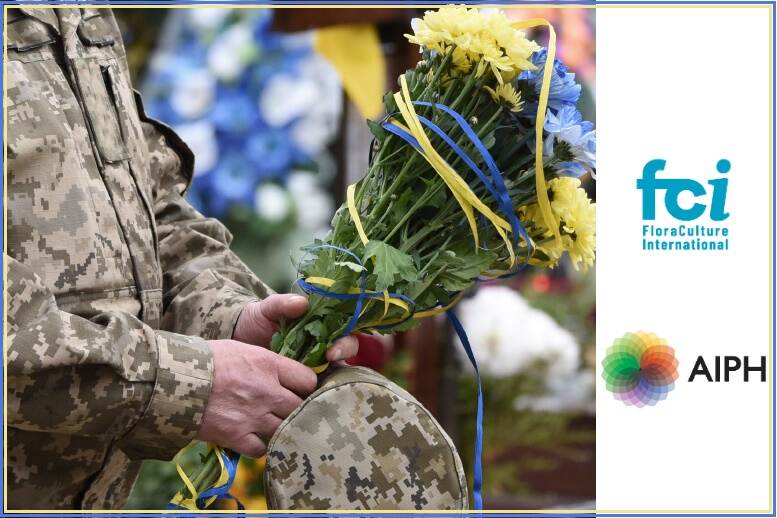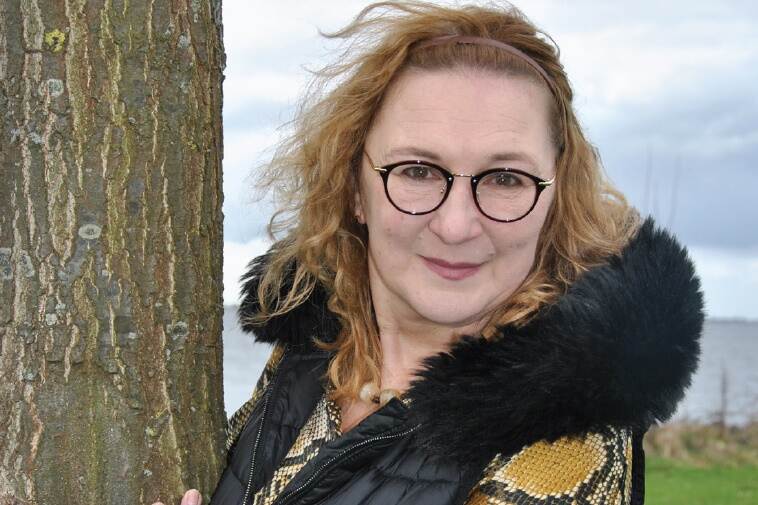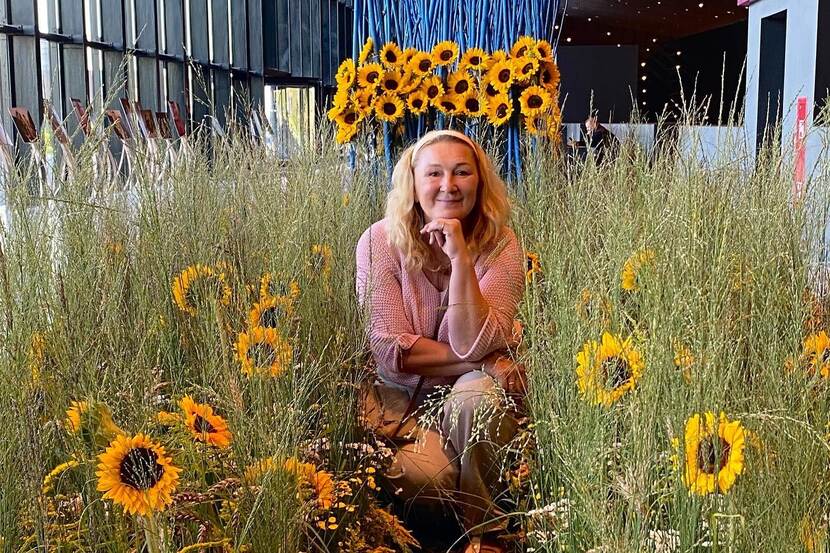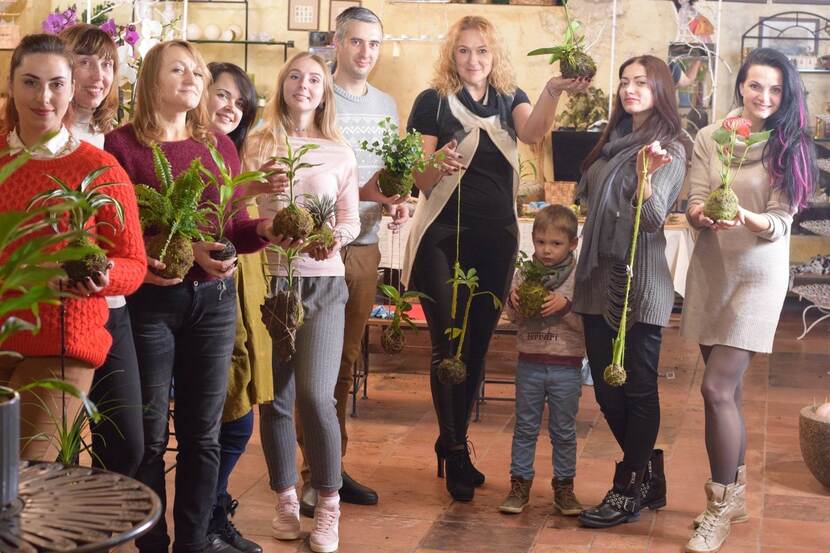FCI: exclusive interview with the president of Ukrainian Florist’s Society
Flowers symbolise the resilience of Ukraine’s people.

After fleeing the Russian missiles raining down on her hometown of Kharkiv with her daughter-in-law, young grandson, and grandmother in March 2022, Iryna Bielobrova escaped the shadow of Putin’s aggression leaving behind her two sons and husband. For the past year, the president of the Ukrainian Florist’s Society has been living as a refugee in the Netherlands.

To acknowledge her fortitude and celebrate International Women’s Day, FCI sat down with Bielobrova to learn about her experiences, the state of the Ukrainian florist industry, her thoughts on the power of flowers and plants to heal, how she is dealing with life currently in the shadow of war, and the challenges of life as a refugee, and what her hopes are for the future.
Iryna Bielobrova was born in Kharkiv, Ukraine, in 1965. Before Russia invaded her hometown, she owned a florist store here and in Kyiv; she taught floristry at her school and is the President of the Ukrainian Florist Society. She continues at the top but under challenging conditions; FCI asked her about her situation and familiarity with the industry she left behind.
FloraCulture International: ‘Pulsating Emotions’ was the title of your Florists Association’s floral installation at FleurAmour 2014, an annual floral design event against the historical backdrop of the Grand Commandery Alden Biesen, Belgium. May we invite you to share with our readers some of your pulsating emotions since Russia began its full-scale invasion of Ukraine a year ago?
Iryna Bielobrova: “In 2014, we participated for the first time in FleurAmour with a desire to tell the world about the impending threat. Back then, eastern Ukraine and Crimea were under military attack for the first time; tensions rose with Ukrainians feeling the threat of war as Russia annexed Crimea. Our installation at FleurAmour was all about those feelings of peril. We used 5,000 Chrysanthemums of different colours to show that unity is our strength regardless of colour. Florists from Dnipro came up with the idea, which was brought to life with support from colleagues from Kharkiv, Kyiv, Lviv, and Lutsk. It was truly a team effort.”
Could you take us back to your life before the invasion; what did you learn in school, and how did you become involved in floristry?
“I spent my childhood in Siberia, far from my homeland. I graduated from art school with painting, composition, and art history classes. At the age of 17, we returned to my native city Kharkiv, Ukraine. I studied philology and teaching at the State University. Following the collapse of the USSR, we began building a new and free Ukraine. Meanwhile, I no longer wanted to pursue an academic career in philology and started teaching floristry. I worked at the Palace of Children’s Art and taught floral design. Flowers have been my hobby since my early childhood. I took various courses and went to exhibitions and various schools in Europe. My students from the Children’s Creativity Palace finished school and became the first florists in Kharkiv. With them, we opened the first florist salon and later the first school of floristry. Now they are the leading florists in Ukraine. They run beautiful flower shops and are active in floral design.”
Who or what inspires you in floristry?
“Nature has always been a rich source of inspiration. I was lucky to live in Siberia, where I grew up amid the taiga, forests, and swamps. Later, when living in Ukraine, I took inspiration from the seemingly endless fields, meadows, and Ukrainian forest steppes. I always loved to grow flowers and create herbaria, souvenirs, and bouquets from them.”

You are the President of the Ukrainian Florists Association. What does this job involve?
“In 2001, Ukrainian florists joined forces to create a public organisation. The founders included flower and floristry aficionados and budding and existing florists who wanted to progress professionally. We gathered in Kyiv to prepare contests and events. The goal was to boost creative skills and take the floristry profession in Ukraine to the next level. After a short break, we again teamed up in 2014, the year that marked participation in international flower design contests and flower shows, the opening of a training and floristry community centre and the membership of Florint – the European Federation of Florist Associations.”
What can you tell us about the state of the Ukrainian floristry sector?
“We have been living with war since 2014, and many of us left our homes and spread across different cities. Floristry developed spontaneously with ups and downs. Flowers are always needed. However, providing stats on floristry in Ukraine is challenging as there is no clear definition of who must be considered a florist. In Ukraine, people import flowers and grow flowers at home, and everyone who sells flowers calls themselves a florist. But some see this profession as an art. We cordially invite flower professionals who want to participate in our organisation to learn about sales strategies and exhibitions and those who want to develop in this industry. Until February last year, our organisation included 200 permanent members, and the organising committee comprised ten active leaders. And thousands of flower ambassadors from different cities gathered for anti-war events.”
How does floral distribution work in Ukraine?
“There are several flower delivery services, including the international one called Interflora and the Ukrainian delivery service called UFL. These are online flower shops and brick-and-mortar stores. Freelance florists in different cities across the country are connected.”
What can you tell us about Ukrainian buying patterns regarding flowers and plants?
“Many flowers are imported from the Netherlands, Kenya, Colombia, and Ecuador. Also, Ukraine hosts a few good producers of roses, Alstroemeria, Lisianthus, tulips, Matthiola, lilies, and irises. New flower farms opened for growing Hydrangeas, peonies, lavender, and summer flowers. Many florists have their area to grow a range of speciality flowers for their shops. Ukraine has fertile land, and growing flowers can be profitable. However, today’s situation looks grim, with many production fields being bombed and destroyed. In some greenhouses, heating was disrupted, and production stopped altogether.”
Can you share any estimate of the retail value of the Ukrainian flower industry?
“Flowers in Ukraine have always been expensive and something special. Ukrainians and flowers are a long-lasting love affair and something which is in our tradition. Due to the war, providing any stats on retail value is impossible. I can only say that the flower industry did not come to a standstill. Everyone who remained in the country is working in full force. Sales volumes are down, but they are there. Everyone is trying to restructure activities for their customers. Suppliers are looking for on-trend merchandising concepts while also focusing on cutting costs and giving a good price to the end consumer. It is amazing how resilient our florists adapt to new conditions.”

What has been the impact on Ukrainian floristry?
“Florists operate in an extremely challenging business environment. Many florists fled the country and took their families abroad; others moved to safer cities, and some changed professions. But I also know that several Ukrainian florists have set up communities abroad. There are around 2,000 Ukrainian florists worldwide that have banded together. They work in flower shops and floral wholesale and continue to be professionally active in floristry even abroad. Our profession is famed for its craftsmanship and dedicated handwork. You can be active in floristry abroad, which is often a good way to learn the language of a country. Meanwhile, many Ukrainian flower shops were forced to close; some moved online. I also would like to commemorate those florists during this terrible year who have held many charity events in different countries and participated in exhibitions and festivals. We promoted our floristry on the pages of magazines and stands of international companies – hardship and the love of flowers unite us.”
When did you decide to leave your country, and tell us about your journey?
“I was caught up in an attack by Russian troops in Western Ukraine. We fled to a sanatorium. In the morning, my son called from Kharkiv, telling me they were being bombed by planes and artillery. I did not return home. I waited for my son’s family to take them to safety. We met in Mukachevo and fled to the Netherlands.”
What made you decide to go to the Netherlands?
“I have known the Netherlands since 1993 and have many friends there in the flower sector. For me, the Netherlands is a calm, positive and reliable country. So, this was not a random choice. I love the Netherlands and want my children and grandchildren to be safe during the hardest years of their lives.”
What does your daily life in the Netherlands look like?
“I am grateful to everyone who welcomed us in the Netherlands. It took quite some time to recover mentally. We travelled the country, visited parks, and my grandson learned to ride a bike. My daughter-in-law works as a florist in a flower shop. The grandson is at school and is learning Dutch. We participate in different programmes. Everything is going well.”
Can you still be active in your area of expertise: floristry?
“I set up floral projects in Belgium, Italy, Poland, and the Netherlands with the support of other Ukrainian florists who moved to the Netherlands and other parts of Europe. The floral installations told people about Ukraine, its culture and traditions, and focused on peace and uniting everyone against war. We communicated in the universal language of flowers and received help from friends across Europe. Their support meant the world to us.”
Did you visit flower shows in Aalsmeer and Vijfhuizen in November 2022, when Ukrainian flower professionals took to social media to criticise the presence of many Russians?
“Yes, of course. We meet our business partners and friends at these shows every year. This year was no exception. Life goes on, and we should not lose touch.”
On 8 April 2022, the European Union published its “Restrictive Measures Regarding Russia’s Actions Destabilising the Situation in Ukraine,” prohibiting EU member states from exporting flower bulbs and seedling products to Russia. This export ban does not apply to freshly cut flowers and potted plants. What are your thoughts about this?
“I believe the isolation of the aggressor country and the terrorist regime should be unequivocal. The world must unite in this. Russia must feel that modern humanity does not want to deal with them.”
You were brave enough to write a letter to Smithers-Oasis, a global flower feed manufacturer, asking them to stop sponsoring the Russian Floristry Cup 2022. Why did you do it?
“The manufacturer is an American company. The European office is in Germany. Are they not our allies? We thought it an opportune moment to point out to the company that their products indirectly sponsored Russia’s revenue. It was a collective decision, and we discussed it with our country’s florists in social media groups.”
Have you written more letters, and what have been the results?
“We strongly advised the organisers of last year’s European championship in floristry, the Europa Cup in Katowice, Poland, to refuse Russia’s participation in the contest. After the postponement due to the Covid-19 pandemic, meeting face-to-face was a great joy for the entire floristry industry. But we didn’t want to see participants from Russia. Organisers of the Florint Championship held a vote among all representatives. As a result, our request was fulfilled. Russian florists came to the championship and covered the event but could not compete for the title of European champion.”
Unlike the Netherlands, International Women’s Day is widely celebrated in Eastern Europe, and Ukraine is no exception. What part of the annual flower sales falls on the Ukraine holiday?
“In Ukraine, there’s a saying between florists; If March sales are good, so will the rest of the year. There’s also an increased focus on Valentine’s Day and Mother’s Day. These three celebrations are undoubtedly the country’s most important floral holidays.”
What about the floral taste of Ukrainians?
“The country is divided into conservatives and modern flower lovers. The first category loves tradition, which often entails giving roses. The other part prefers spring flowers, mixed bouquets, bouquets with exotic flowers and greenery, and dried flowers. I would say that Ukrainian caters to happy and grateful customers. People love creative work and ask for interesting new varieties.”
Will a country under siege continue to celebrate its holidays with flowers?
“The answer is unequivocal: YES, it will. Flowers are emotions; they are beautiful and project our love and care. There are very few positive emotions in wartime, and flowers are a way to bring joy.”
What about product availability?
“There will be flowers in Ukraine. They bloom in our greenhouses and come to us via the Dutch auctions.”
Speaking about women in floriculture and floristry, what one piece of advice would you give to a woman starting in this field?
“Flowers often take people on a journey of a lifetime. You must be positive, resourceful, have good health and love people. The industry will teach you the rest.”
How important is the issue of gender balance?
“I see no reason to worry about gender balance. Floristry is for the delicate soul and lovers of beauty. It is for those who love nature, art, show and handicraft. They are creative people. It does not matter what gender they are. It is generally believed that these qualities are more apparent in women. But some men are sophisticated and creative. However, we must not forget that floristry is physically taxing work, and there is a need for male ingenuity, strength, abilities and skills. In our country, there are many florist families. A woman creates them, and a man helps finance her fantasies. Which one is the florist?”
Currently, what helps you to progress in life?
“I strongly believe that the good will always conquer the evil. In that beauty will save the world. Friendship and human interaction can defeat a sick mind and aggression. I believe the world will be better if we all work together to get rid of guns and war. I believe that my country will rebuild its cities and grow new gardens. I believe our children and grandchildren will return to build a new Ukraine. This faith helps me to live and progress.”
This war will not end anytime soon. What does the future hold for your family?
“I have a very patriotic family. Certainly, now our task is to save lives and learn to live under different conditions. Personally, I want to return home as soon as possible. We need to stay as safe as possible for the kids. Learn languages, play sports, develop, and make connections. To preserve their identity. To tell the world about their traditions. My ten-year-old grandson said he will study hard and return to build his Ukraine. My hopes for the future? The answer is likely to be the same as any other Ukrainian: The hope is to defeat terrorism, terrorism in any country. The world must liberate the planet from Russian terror.”
What final message would you like to give to the world community of flower professionals?
“I want to tell my colleagues in the flower profession that we have a great opportunity to improve the world through flowers. We must always stay in the line of work and do our part with quality and great love. The plant gives us its example, how from a small seed is born a beautiful flower, then the fruit. This is how life goes on the planet yearly for millions of years. We, florists, create moments of admiring the flower and the plant. It brings us back to our roots. It allows us to make the world beautiful and harmonious. Ultimately, we are lucky to work in such a beautiful sector.”
Source:
https://aiph.org/floraculture/news/flowers-symbolise-the-resilience-of-ukraines-people/
Read the full edition FCI March 2023 https://aiph.org/floraculture/latest-edition/?fbclid=IwAR1PnV1AjkVyrjPl8vrChg-cpg1SijjT511wTMXJfRUqNfTzBRU-ROfYKlU